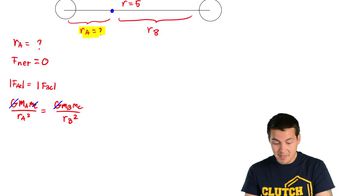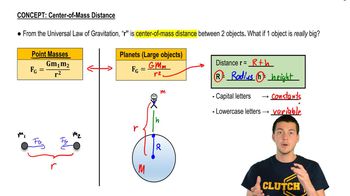>> Let's talk about gravity that you are all familiar with. Which is when you are standing on the surface of the Earth. Which you will likely do for most of your life. You'll certainly go up in airplanes and you probably go down in caves, but for most of your life you're going to be standing on the surface of the Earth. Unless, you know, commercial space travel takes off and you guys can afford the $100,000 ticket on the spaceships, you know, and you can go up into outer space. That would be pretty cool. Hopefully those prices will come down a little bit. Do they have like an Expedia for space travel? What is the force on us? Well, we're clearly at the radius of the Earth. The Earth is roughly a sphere. It's not really a sphere, okay? It's a little bit bulged out in the center because it's spinning. The equator sort of bulges out a little bit. The Poles shrunk in a little bit. So, it's not really round, but it's closeish to round. We know that there's a force on us, because there is this big mass underneath us. The mass of the Earth, which is pulling us towards the center of the Earth. Let's calculate what that force is. What we just said was, "The force is GM1M2 over R squared." The negative sign indicates it's going down towards the center of the Earth. So, attractive force. Now we can punch in some of these numbers. Mass of the Earth there. The mass of us right there. The radius of the Earth squared right there. Okay? Let's rewrite this slightly. And let's put GMER squared. Put all that stuff second. And now let's punch in some of these numbers. So, what do we have for these numbers? Does anybody know what the mass of the Earth is? These are all SI units. Anybody know what the mass of the Earth is? Okay, what do you do when you're trying to figure out something these days, right? You pull out your phone and you immediately Google, "What's the mass of the Earth?" Okay. Why don't you do that right now and tell me what you find. Pull out your phone and try it. I know they told you to turn your phone off and I'm telling you to turn it back on and try it. Figure out the mass of the Earth and the radius of the Earth. >> 5.9 times 10 to the 24th kilogram. >> 5.9 times 10 to the 24th kilogram. Is that a reputable source that you're getting that number from? >> It was the first thing that popped up on Google. >> Okay. That's probably fairly reputable. If anybody else gets a different number let me know. What about the radius of the Earth? >> 6378.1 kilometers. >> 6378 point -- >> 1 kilometers. >> Okay. >> Is that right? Andy did I write that down right? 6.37 times 10 to the 6th? >> Yeah. >> And we said that the units of G, of course, were Newton meter squared per kilogram squared. Okay, so we take all those numbers and we punch them in here. Why don't you guys try that in your calculator and tell me what you get. And I will tell you what I get if I just approximate it in my head. I'm going to say it's 9.8 meters per second squared. >> I, of course, cheated, because I knew the answer. But double check and make sure if you punch in all those numbers you get 9.8 meters per second squared. >> What we know is that force has to be equal to mass times acceleration. So, the acceleration, due to gravity, at the Earth's surface is negative 9.8 meters per second squared, which is what we call negative G. That's where that 9.8 comes from, right? We've been hearing about 9.8 meters per second squared over and over and over, where does it come from? It comes from Newton's universal law of gravitation. If you put in the mass of the Earth and you put in the radius of the Earth into this equation. You put those numbers in here, you get negative G. Which I think is kind of cool, right? Kind of ties it all back together.
Table of contents
- 0. Math Review31m
- 1. Intro to Physics Units1h 23m
- 2. 1D Motion / Kinematics3h 56m
- Vectors, Scalars, & Displacement13m
- Average Velocity32m
- Intro to Acceleration7m
- Position-Time Graphs & Velocity26m
- Conceptual Problems with Position-Time Graphs22m
- Velocity-Time Graphs & Acceleration5m
- Calculating Displacement from Velocity-Time Graphs15m
- Conceptual Problems with Velocity-Time Graphs10m
- Calculating Change in Velocity from Acceleration-Time Graphs10m
- Graphing Position, Velocity, and Acceleration Graphs11m
- Kinematics Equations37m
- Vertical Motion and Free Fall19m
- Catch/Overtake Problems23m
- 3. Vectors2h 43m
- Review of Vectors vs. Scalars1m
- Introduction to Vectors7m
- Adding Vectors Graphically22m
- Vector Composition & Decomposition11m
- Adding Vectors by Components13m
- Trig Review24m
- Unit Vectors15m
- Introduction to Dot Product (Scalar Product)12m
- Calculating Dot Product Using Components12m
- Intro to Cross Product (Vector Product)23m
- Calculating Cross Product Using Components17m
- 4. 2D Kinematics1h 42m
- 5. Projectile Motion3h 6m
- 6. Intro to Forces (Dynamics)3h 22m
- 7. Friction, Inclines, Systems2h 44m
- 8. Centripetal Forces & Gravitation7h 26m
- Uniform Circular Motion7m
- Period and Frequency in Uniform Circular Motion20m
- Centripetal Forces15m
- Vertical Centripetal Forces10m
- Flat Curves9m
- Banked Curves10m
- Newton's Law of Gravity30m
- Gravitational Forces in 2D25m
- Acceleration Due to Gravity13m
- Satellite Motion: Intro5m
- Satellite Motion: Speed & Period35m
- Geosynchronous Orbits15m
- Overview of Kepler's Laws5m
- Kepler's First Law11m
- Kepler's Third Law16m
- Kepler's Third Law for Elliptical Orbits15m
- Gravitational Potential Energy21m
- Gravitational Potential Energy for Systems of Masses17m
- Escape Velocity21m
- Energy of Circular Orbits23m
- Energy of Elliptical Orbits36m
- Black Holes16m
- Gravitational Force Inside the Earth13m
- Mass Distribution with Calculus45m
- 9. Work & Energy1h 59m
- 10. Conservation of Energy2h 54m
- Intro to Energy Types3m
- Gravitational Potential Energy10m
- Intro to Conservation of Energy32m
- Energy with Non-Conservative Forces20m
- Springs & Elastic Potential Energy19m
- Solving Projectile Motion Using Energy13m
- Motion Along Curved Paths4m
- Rollercoaster Problems13m
- Pendulum Problems13m
- Energy in Connected Objects (Systems)24m
- Force & Potential Energy18m
- 11. Momentum & Impulse3h 40m
- Intro to Momentum11m
- Intro to Impulse14m
- Impulse with Variable Forces12m
- Intro to Conservation of Momentum17m
- Push-Away Problems19m
- Types of Collisions4m
- Completely Inelastic Collisions28m
- Adding Mass to a Moving System8m
- Collisions & Motion (Momentum & Energy)26m
- Ballistic Pendulum14m
- Collisions with Springs13m
- Elastic Collisions24m
- How to Identify the Type of Collision9m
- Intro to Center of Mass15m
- 12. Rotational Kinematics2h 59m
- 13. Rotational Inertia & Energy7h 4m
- More Conservation of Energy Problems54m
- Conservation of Energy in Rolling Motion45m
- Parallel Axis Theorem13m
- Intro to Moment of Inertia28m
- Moment of Inertia via Integration18m
- Moment of Inertia of Systems23m
- Moment of Inertia & Mass Distribution10m
- Intro to Rotational Kinetic Energy16m
- Energy of Rolling Motion18m
- Types of Motion & Energy24m
- Conservation of Energy with Rotation35m
- Torque with Kinematic Equations56m
- Rotational Dynamics with Two Motions50m
- Rotational Dynamics of Rolling Motion27m
- 14. Torque & Rotational Dynamics2h 5m
- 15. Rotational Equilibrium3h 39m
- 16. Angular Momentum3h 6m
- Opening/Closing Arms on Rotating Stool18m
- Conservation of Angular Momentum46m
- Angular Momentum & Newton's Second Law10m
- Intro to Angular Collisions15m
- Jumping Into/Out of Moving Disc23m
- Spinning on String of Variable Length20m
- Angular Collisions with Linear Motion8m
- Intro to Angular Momentum15m
- Angular Momentum of a Point Mass21m
- Angular Momentum of Objects in Linear Motion7m
- 17. Periodic Motion2h 9m
- 18. Waves & Sound3h 40m
- Intro to Waves11m
- Velocity of Transverse Waves21m
- Velocity of Longitudinal Waves11m
- Wave Functions31m
- Phase Constant14m
- Average Power of Waves on Strings10m
- Wave Intensity19m
- Sound Intensity13m
- Wave Interference8m
- Superposition of Wave Functions3m
- Standing Waves30m
- Standing Wave Functions14m
- Standing Sound Waves12m
- Beats8m
- The Doppler Effect7m
- 19. Fluid Mechanics2h 27m
- 20. Heat and Temperature3h 7m
- Temperature16m
- Linear Thermal Expansion14m
- Volume Thermal Expansion14m
- Moles and Avogadro's Number14m
- Specific Heat & Temperature Changes12m
- Latent Heat & Phase Changes16m
- Intro to Calorimetry21m
- Calorimetry with Temperature and Phase Changes15m
- Advanced Calorimetry: Equilibrium Temperature with Phase Changes9m
- Phase Diagrams, Triple Points and Critical Points6m
- Heat Transfer44m
- 21. Kinetic Theory of Ideal Gases1h 50m
- 22. The First Law of Thermodynamics1h 26m
- 23. The Second Law of Thermodynamics3h 11m
- 24. Electric Force & Field; Gauss' Law3h 42m
- 25. Electric Potential1h 51m
- 26. Capacitors & Dielectrics2h 2m
- 27. Resistors & DC Circuits3h 8m
- 28. Magnetic Fields and Forces2h 23m
- 29. Sources of Magnetic Field2h 30m
- Magnetic Field Produced by Moving Charges10m
- Magnetic Field Produced by Straight Currents27m
- Magnetic Force Between Parallel Currents12m
- Magnetic Force Between Two Moving Charges9m
- Magnetic Field Produced by Loops and Solenoids42m
- Toroidal Solenoids aka Toroids12m
- Biot-Savart Law (Calculus)18m
- Ampere's Law (Calculus)17m
- 30. Induction and Inductance3h 37m
- 31. Alternating Current2h 37m
- Alternating Voltages and Currents18m
- RMS Current and Voltage9m
- Phasors20m
- Resistors in AC Circuits9m
- Phasors for Resistors7m
- Capacitors in AC Circuits16m
- Phasors for Capacitors8m
- Inductors in AC Circuits13m
- Phasors for Inductors7m
- Impedance in AC Circuits18m
- Series LRC Circuits11m
- Resonance in Series LRC Circuits10m
- Power in AC Circuits5m
- 32. Electromagnetic Waves2h 14m
- 33. Geometric Optics2h 57m
- 34. Wave Optics1h 15m
- 35. Special Relativity2h 10m
8. Centripetal Forces & Gravitation
Newton's Law of Gravity
Video duration:
5mPlay a video:
Related Videos
Related Practice

















